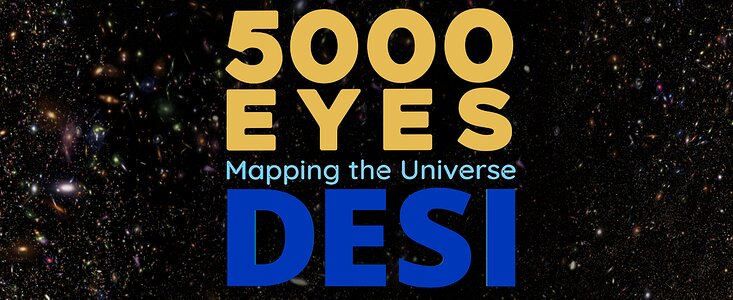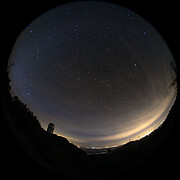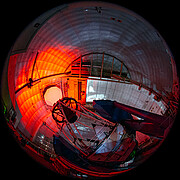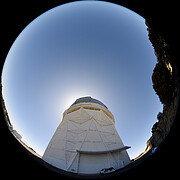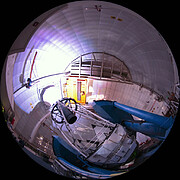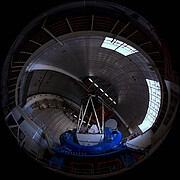New DESI Planetarium Show Available for Download
5000 Eyes: Mapping the Universe with DESI presents a 3D fly-through of the project’s first year of data
2 March 2023
A stunning new documentary film featuring recent discoveries from the Department of Energy’s Dark Energy Spectroscopic Instrument (DESI) at Kitt Peak National Observatory (KPNO) has been released and is free to download for planetariums worldwide. 5000 Eyes: Mapping the Universe with DESI is a new feature-length planetarium show created in collaboration with DESI’s consortium of worldwide collaborators, a dedicated group of scientists and engineers who are producing the most complete map of our Universe.
DESI, led by the Lawrence Berkeley National Laboratory, is the most powerful multi-object survey spectrograph in the world. With its 5000 fiber-optic ‘eyes’ that feed an array of ten high-efficiency spectrographs, DESI is aimed at measuring the effect of dark energy on the expansion of the Universe. By analyzing the gravitational clustering of galaxies, quasars, and intergalactic gas clouds, DESI will derive the most precise constraints on the nature of dark energy.
The DESI project was originally proposed over a decade ago, and construction began in 2015 at the Nicholas U. Mayall Telescope at KPNO, near Tucson, Arizona. KPNO is a Program of NSF’s NOIRLab.
The DESI instrument saw first light in late 2019, but the validation phase was delayed by the onset of global coronavirus pandemic. Testing resumed in December 2020 and DESI finally started operating in May 2021. During its first seven months, DESI broke all previous records for three-dimensional galaxy surveys, and then after another brief hiatus in late 2021 due to a massive wildfire on Kitt Peak, which threatened the observatory, DESI resumed its task of cataloging the cosmos. DESI’s first year of data has now been transformed into a 3D visualization for viewers to experience as an immersive fly-through voyage.
The 22-minute planetarium film provides a rare glimpse into modern cosmology by introducing viewers to DESI researchers and featuring original footage of the telescope and interviews with DESI scientists from all over the world. The film’s exciting conclusion is a fly-through of DESI’s first year of data. The positions of over 14 million extragalactic objects are visualized in 3D for the first time, revealing the largest structures in the Universe as never seen before.
DESI Director, Michael Levi, a senior scientist in Berkeley Lab’s Physics Division, is enthusiastic about this new presentation: “The quality of the three dimensional data is breathtaking in its beauty and ability to reveal the hidden large-scale structures of the Universe. The fly-through in the film lets the viewer peer back in time to billions of years ago.”
“The DESI collaboration is so excited to share this new planetarium show, which is filled with beautiful visualizations of the data and the instrument that we have proudly worked on for many years. This new documentary highlights the exciting contributions that DESI is making to improve our understanding of the Universe,” said Parker Fagrelius, an astronomer at NSFs NOIRLab who previously led the DESI outreach committee.
This new feature-length planetarium show, created by the Fiske Productions (University of Colorado Boulder) and directed by Claire Lamman, is being distributed for free to planetariums worldwide.
According to Levi, “The DESI collaboration funded this production in part to give our early career scientists a means to express and share their excitement in doing world-class research. Their youthful exuberance comes through and I am thrilled for everyone to see it.”
More information
DESI is supported by the US Department of Energy’s Office of High Energy Physics; the US National Science Foundation, Division of Astronomical Sciences under contract to the NSF’s NOIRLab; the Science and Technologies Facilities Council of the United Kingdom; the Gordon and Betty Moore Foundation; the Heising-Simons Foundation; the French Alternative Energies and Atomic Energy Commission (CEA); the National Council of Science and Technology of Mexico; the Ministry of Economy of Spain; and DESI member institutions. The DESI scientists are honored to be permitted to conduct astronomical research on Iolkam Du’ag (Kitt Peak), a mountain with particular significance to the Tohono O'odham Nation.
NSF’s NOIRLab (National Optical-Infrared Astronomy Research Laboratory), the US center for ground-based optical-infrared astronomy, operates the International Gemini Observatory (a facility of NSF, NRC–Canada, ANID–Chile, MCTIC–Brazil, MINCyT–Argentina, and KASI–Republic of Korea), Kitt Peak National Observatory (KPNO), Cerro Tololo Inter-American Observatory (CTIO), the Community Science and Data Center (CSDC), and Vera C. Rubin Observatory (operated in cooperation with the Department of Energy’s SLAC National Accelerator Laboratory). It is managed by the Association of Universities for Research in Astronomy (AURA) under a cooperative agreement with NSF and is headquartered in Tucson, Arizona. The astronomical community is honored to have the opportunity to conduct astronomical research on Iolkam Du’ag (Kitt Peak) in Arizona, on Maunakea in Hawai‘i, and on Cerro Tololo and Cerro Pachón in Chile. We recognize and acknowledge the very significant cultural role and reverence that these sites have to the Tohono O’odham Nation, to the Native Hawaiian community, and to the local communities in Chile, respectively.
Links
- Download “5000 Eyes: Mapping the Universe with DESI”
- “5000 Eyes: Mapping the Universe with DESI” Trailer
- Berkeley Labs press release
- Legacy Surveys viewer
- Photos of DESI
- Videos of DESI
- Photos of the Nicholas U. Mayall 4-meter Telescope
Contacts
Charles Blue
Public Information Officer
NSF’s NOIRLab
T: +1 202 236 6324
Email: charles.blue@noirlab.edu

